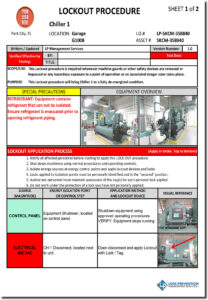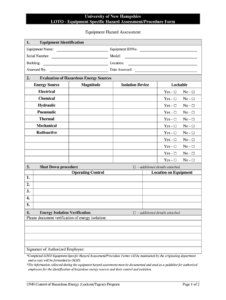A lockout tag out (LOTO) policy template, often created by safety managers, is a comprehensive document that outlines the specific procedures and guidelines for implementing a LOTO program within a workplace.
This policy template provides a standardized approach to ensure the safe isolation and de-energizing of hazardous energy sources during maintenance, repair, and other servicing activities to prevent accidental startups or the release of hazardous energy.
Components of a Lock Out Tag Out Policy Template
LOTO Program Overview
A comprehensive lockout tag out policy template includes an overview of the LOTO program, its purpose, objectives, and the scope of its application. This section also outlines the roles and responsibilities of personnel involved in LOTO activities, including authorized employees, supervisors, and safety personnel.
Procedures for Lock Out Tag Out
The template provides detailed procedures for conducting a lockout tag out effectively. These procedures include identifying and isolating energy sources, affixing locks and tags to energy isolation devices, verifying the isolation of energy, and testing the effectiveness of the LOTO.
Training and Authorization
The policy template addresses the training and authorization requirements for employees who perform LOTO activities. It specifies the training content, frequency, and documentation requirements. The template also outlines the process for authorizing employees to conduct LOTO procedures.
Inspections and Audits
The policy template establishes a system for regular inspections and audits of the LOTO program. These inspections and audits aim to ensure compliance with the LOTO policy and identify areas for improvement.
The template also includes provisions for addressing non-compliance, incident investigation, and corrective actions.
Benefits of Using a Lock Out Tag Out Policy Template
Standardization and Consistency
A lockout tag out policy template provides a standardized and consistent approach to LOTO procedures throughout the organization. This ensures that all employees follow the same steps and adhere to the same safety protocols, reducing the risk of accidents.
Legal Compliance
The policy template helps organizations comply with applicable safety regulations and standards related to lockout tag out procedures. By following the guidelines outlined in the template, organizations can demonstrate their commitment to workplace safety and minimize their liability.
Improved Safety Culture
A well-implemented LOTO policy template fosters a positive safety culture within the organization. Employees recognize the importance of LOTO procedures and their role in preventing accidents. This leads to increased awareness of safety hazards and a proactive approach to risk management.
Conclusion
A well-crafted and implemented lockout tag out policy template is a vital safety tool for organizations. It provides a structured framework for controlling hazardous energy, minimizing the risk of accidents, and ensuring compliance with safety regulations.
By adopting a comprehensive LOTO policy template, organizations can create a safer work environment for their employees and demonstrate their commitment to workplace safety.
FAQ
What is the purpose of a lockout tag out policy template?
A lockout tag out policy template provides a standardized and consistent approach to lockout tag out procedures, ensuring the safe isolation of hazardous energy sources during maintenance and servicing activities.
What are the key components of a lockout tag out policy template?
A lockout tag out policy template typically includes an overview of the LOTO program, procedures for conducting LOTO, training and authorization requirements, and provisions for inspections, audits, and non-compliance.
What are the benefits of using a lockout tag out policy template?
A lockout tag out policy template promotes standardization and consistency, facilitates legal compliance, and fosters a positive safety culture, ultimately reducing the risk of accidents and improving workplace safety.

